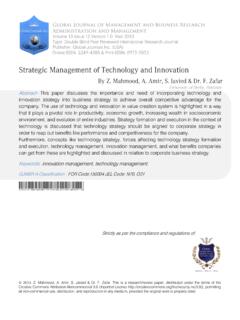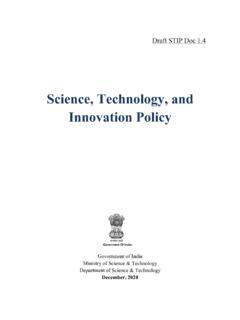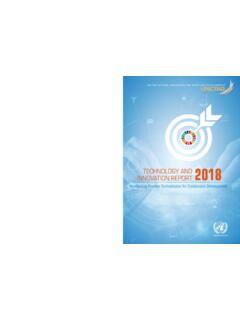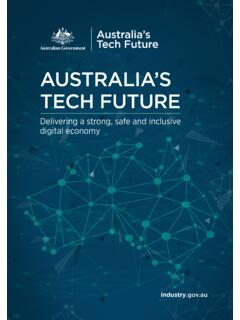Transcription of Technology and innovation in the insurance sector - OECD
1 Technology and innovation in the insurance sector Technology AND innovation IN THE insurance sector This work is published under the responsibility of the Secretary-General of the OECD. The opinions expressed and arguments employed herein do not necessarily reflect the official views of the OECD or of the governments of its member countries or those of the European Union. This document and any map included herein are without prejudice to the status or sovereignty over any territory, to the delimitation of international frontiers and boundaries and to the name of any territory, city, or area. OECD 2017 Please cite this publication as: OECD (2017), Technology and innovation in the insurance sector FOREWORD 3 Technology AND innovation IN THE insurance sector Foreword Insurtech is the term being used to describe the new technologies with the potential to bring innovation to the insurance sector and impact the regulatory practices of insurance markets.
2 This report catalogues these technologies and examines how InsurTech is being funded and how insurers are engaging with the start-ups entering the market. This report was prepared as part of the programme of work of the OECD insurance and Private Pensions Committee, the international forum for addressing policy and regulatory issues in insurance and private pensions for governments, international organisations and industry. It has benefited from input from the insurance market and industry, including from a number of insurance start-ups. This report contributes to the OECD s Going Digital project which is examining from a wide range of perspectives how Technology and innovation is affecting the economy. TABLE OF CONTENTS 5 Technology AND innovation IN THE insurance sector Table of contents Executive summary.
3 7 1. Introduction .. 8 2. Funding of InsurTech .. 11 3. insurance intermediation and distribution models .. 16 4. The sharing economy and insurance .. 21 5. Robo-advice and AI .. 23 6. Data aggregation and analytics .. 26 7. The role of policy and regulation in InsurTech .. 29 insurance regulation and innovation hubs .. 29 AI and the regulation of Technology -based 34 Privacy and data protection issues .. 34 RegTech .. 36 Wider policy considerations .. 38 8. Conclusions .. 40 References .. 42 Figures 1. InsurTech financing trend (2011-2016) .. 13 2. InsurTech deal activity by focus area (US only, health vs non-health) .. 13 3. Tech start-up investment by (re)insurers (2012-2016) .. 14 Boxes Box 1. OECD Work on FinTech .. 10 Box 2.
4 Technology relevant to InsurTech .. 11 Box 3. Funding of InsurTech by (re)insurers .. 14 Box 4. BIMA .. 16 Box 5. Friendsurance, InsPeer and Guevara .. 17 Box 6. Lemonade .. 18 Box 7. The use of blockchains in insurance .. 19 Box 8. Robo-advice for insurance .. 24 Box 9. PolicyGenius .. 24 Box 10. Estonian insurance Association s motor insurance database .. 28 Box 11. Monetary Authority of Singapore's approach .. 30 Box 12. The UK Financial Conduct Authority s Project Innovate .. 31 6 TABLE OF CONTENTS Box 13. Autonomous cars and insurance .. 33 Box 14. EU General Data Protection Regulation (GDPR) .. 36 Box 15. RegTech and algorithms .. 37 Box 16. Estonia s electronic ID card and digital signature services .. 39 EXECUTIVE SUMMARY 7 Technology AND innovation IN THE insurance sector Executive summary innovation through new technologies is a key driver of change in the financial sector and this has led to immeasurable efficiency gains, even though these changes can initially be accompanied by uncertainty and doubt.
5 The insurance sector is no exception to such developments, with possibilities of new methods of service provision as well as greater opportunities for data collection and fraud detection that can lead to better risk identification and mitigation measures, which are being referred to as InsurTech . This report catalogues the relevant technologies that are being viewed as having the potential to bring innovation to the insurance sector . How InsurTech is being funded is examined, as this indicates which markets are actively investing in start-ups and how insurers are engaging with start-ups. Case studies are made of insurance start-ups, and how blockchain Technology , sharing economy, robo-advice and data aggregation are influencing the insurance sector is discussed.
6 The manner in which insurers engage Technology to ensure better compliance with regulation is also examined. innovation and new technologies have the potential to affect the franchise value of insurance companies, with accompanying competition policy considerations. Policies which have tailored coverage and simplified claims processes can improve coverage to segments of society that hitherto were not able to access financial protection. Regulatory approaches, such as the regulatory sandbox being developed by a number of jurisdictions, may bridge greater competition and prudential requirements, although ensuring a level playing field as solutions graduate into the full market require some consideration.
7 There are a number of areas in which greater regulatory discussion should take place, as the transparency of the Technology and the impact on policyholder s choice and rights may not be clear. Data protection is an area that will require closer examination by regulators, as the volume of personal data handled by insurers increases, whether consensus was gained for the intended use becomes blurred. Data aggregation brings forth the possibility of certain segment of the population becoming uninsurable, so how data is harnessed should be closely considered. The treatment of algorithms is also an area for further discussion to ensure that the assumptions built in are appropriate and unintended consequences are avoided in so far as possible, and regulators have a means of engaging in this assessment.
8 These could have implications on the ongoing monitoring of operational risk and internal control of insurers. Ensuring that policyholders are fairly treated and appropriately protected when the implications of certain innovations and technologies are uncertain will be important going forward. As emerging markets have less of an established distribution network of insurance , innovation and Technology may have the greatest impact in such markets. Nevertheless, whether developed or emerging, appropriate regulatory monitoring should be carried out to ensure that the welfare of policyholders is safeguarded. There are number of ways in which regulatory approaches could be considered for InsurTech, but as well in the wider FinTech realm.
9 The OECD is engaging with FinTech issues in a number of ways, and further areas of discussion are proposed. This report is part of a wider project by the OECD on FinTech developments, as well as the OECD horizontal project on Seizing the Benefits of Digitalisation for Growth and Well-Being. 8 1. INTRODUCTION 1. Introduction innovation through new technologies is a key driver of change in the financial sector and this has led to immeasurable efficiency gains, even though these changes can initially be accompanied by uncertainty and doubt. In recent years, such innovation has happened on the back of new technological developments, with the phenomenon often being described as FinTech.
10 As financial services deal in intangible products, it is well suited for technological innovation to lower transaction costs and expedite the delivery of services. Although this has, in fact, been happening over the history of finance, the recent proliferation of internet connections, home computing and mobile devices, and the development of applications has led to the possibility of lowering the barrier for market entry, paving the way for greater competition in or disruption of the financial industry. However, slating technological and innovation as disruptive Technology can be misleading, and it is likely to be more a hindsight observation than the everyday trial and error that accompanies innovation and technological advances.


















